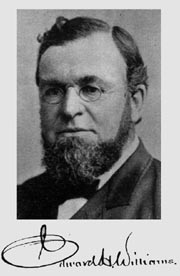Edward H. Williams
Dr. Edward H. Williams | |
|---|---|
 | |
| Born | June 1, 1824 |
| Died | December 21, 1899 (aged 75) |
| Education | Vermont Medical College Woodstock |
| Occupation(s) | Physician, railroad executive |
Edward Higginson Williams[1] (June 1, 1824 – December 21, 1899) was an American physician and railroad executive known for his philanthropy.
Early life and medical career[edit]
Williams was born on June 1, 1824, in Woodstock, Vermont to Vermont Secretary of State Norman Williams and Mary Ann Wentworth (Brown) Williams.[1] He graduated from Vermont Medical College in Woodstock[2] and worked for a time as a physician. While working on the Rutland & Burlington railroad in Cavendish, Vermont, with his former physics teacher Hosea Doton,[3] he was the first physician to treat brain-injury survivor Phineas Gage after Gage accidentally blasted a tamping iron through his jaw and skull while setting an explosive charge.[4] This event occurred three months after his marriage to Cornelia Bailey Pratt in Woodstock June 15, 1848.[5] A year later they were still in Proctorville, near Cavendish and about 20 miles south of Woodstock when their son Edward H. Williams Jr. was born.[6] By 1850, Edward, Cornelia and their new son had settled in Northfield, where he was practicing medicine with his brother-in-law Dr. Samuel White Thayer.[7] Together Williams and Thayer were civically active in the village of Northfield forming an Odd Fellows lodge and establishing a new Episcopal Church congregation in 1851.[8]
Williams later became a member of the Royal Swedish Academy of Sciences and was decorated as a Knight of the Order of the Polar Star.[1]
Railroad executive[edit]
Williams gave up medicine to work in the railroad industry.[9] He left Vermont and resided in the Rosemont suburb of Philadelphia.[1] Williams became well known in the U.S. for his work with the firm of Burnham, Williams, & Co. In 1870, he joined the Baldwin Locomotive Works.[9]
In addition to his railroad activities, Williams also served as a U.S. commissioner to the Sydney International Exhibition in 1879 and the Melbourne International Exhibition in 1880.[1]
Philanthropy[edit]
Williams gave prominently towards education. He constructed and equipped buildings for the teaching of science at Carleton College (dedicated in memory of his son William) and the University of Vermont (in memory of his wife). He also made large donations to the University of Pennsylvania and other educational institutions.[1] Williams donated a library building to his hometown of Woodstock, Vermont as well.[9]
Personal life and death[edit]
Williams was elected a member of the American Philosophical Society in 1897.[10]
Williams was married to Cornella Bailey. They had three children: Edward Higginson Williams Jr., William Williams, and Anna (Williams) Dreer.[1]
Williams died on December 21, 1899, in Santa Barbara, California. The cause of death was described as “heart troubles”.[9]
References[edit]
- ^ a b c d e f g Muskett, Joseph James, ed. (1900). "Appleton of New England". Suffolk Manorial Families. 1. Exeter: William Pollard & Co: 334. Retrieved February 20, 2014.
- ^ https://jamanetwork.com/journals/jamasurgery/fullarticle/391303
- ^ https://hartfordvthistory.com/wp-content/uploads/2023/12/Memorandum-for-1872.pdf
- ^
Macmillan, M. (2000). An Odd Kind of Fame: Stories of Phineas Gage. MIT Press. ISBN 0-262-13363-6. (hbk, 2000) (pbk, 2002).

- ^ https://www.cromwellbutlers.com/gallry18.htm
- ^ https://www.tbp.org/about/founder.cfm
- ^ https://jamanetwork.com/journals/jamasurgery/fullarticle/391303
- ^ McIntire, Julia W. (1974). Green mountain heritage: the chronicle of Northfield Vermont. Phoenix Publishing, Canaan NH. ISBN 0-914016-08-3. pg. 159; 172.
- ^ a b c d DR. EDWARD H. WILLIAMS DEAD. – Part Owner of Baldwin Locomotive Works Succumbs to Heart Trouble. New York Times, December 22, 1899
- ^ "APS Member History". search.amphilsoc.org. Retrieved 2024-02-22.
External links[edit]
- 1824 births
- 1899 deaths
- American railroad executives
- Knights of the Order of the Polar Star
- Members of the Royal Swedish Academy of Sciences
- People from Woodstock, Vermont
- People from Cavendish, Vermont
- Physicians from Philadelphia
- Physicians from Vermont
- 19th-century American businesspeople
- Members of the American Philosophical Society
